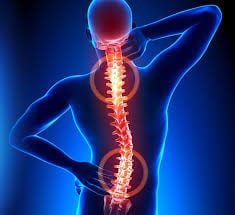Contents
General description of the disease
Osteochondrosis is a back disease characterized by degenerative-dystrophic changes in the spine. The disease affects the intervertebral discs, the adjacent joints of the vertebrae, the ligamentous apparatus of the spine.
Causes and prerequisites for the development of osteochondrosis
uneven load on the spine, psychoemotional blocks, prolonged static and tense postures (driving a car or working at a computer), persistent muscle spasm, heredity, overload of the spine (carrying weights, obesity), trauma and damage to the spine.
Symptoms of osteochondrosis
Usually they include: violations of the sensitivity of the back, pain of various nature (headache, heart, lumbar and back pain), disruption of the internal organs, increased pain during physical exertion, sneezing and coughing, sudden movements, lifting weights, muscle atrophy, aching or numbness in the limbs. The symptoms of osteochondrosis depend on the stage of its development and the type of disease:
- with cervical osteochondrosis: vertebral artery syndrome (dizziness, flickering of colored spots and “flies” before the eyes), headache, which increases with neck movements and in the morning, loss of consciousness, pain in the shoulders and arms with a slight load;
- with thoracic osteochondrosis: pain in the thoracic spine, intercostal neuralgia, pain in the heart;
- with lumbar osteochondrosis: pain in the lumbar region, radiating to the sacrum, legs, pelvic organs, numbness of the thighs, legs and feet, spasm of the leg arteries.
Useful products for osteochondrosis
A lax diet for osteochondrosis should comply with the principles of rational nutrition and be low-calorie, balanced, rich in minerals and vitamins, and also contain foods with chondroprotectors.
In case of illness, you should eat steamed food, at least six times a day and in small portions. Among the useful products are:
- dairy products (natural cheeses, yogurt, kefir, yogurt, fermented baked milk);
- fresh vegetables and greens in the form of salads, vinaigrette (sorrel, lettuce, tomatoes, cucumbers, onions, peppers, carrots, radishes, beets, parsley, celery, cauliflower and white cabbage, broccoli);
- fresh fruits and fruit jellies;
- olive oil or lemon juice for dressing;
- lean boiled meat (rabbit, beef, skinless chicken);
- berries (for example, sea buckthorn);
- jellied meat, jelly, jellied meat and fish (contain mucopolysaccharides, protein, collagen);
- gray, rye or bran bread, crispbread, non-sweet and unsweetened cookies, biscuit;
- protein products (eggs, milk, seeds, soybeans, nuts, brewer’s yeast, eggplant, whole unprocessed grains of millet, wheat, buckwheat, corn, barley);
- foods with a high vitamin A content (liver, peaches, artichokes, melon, pumpkin);
- foods that contain calcium (sesame seeds, almonds, nettles, watercress, rose hips);
- foods with a high content of vitamins D (sea fish, butter);
- Foods that contain magnesium (sunflower seeds, raw spinach, avocados, bean pods)
- foods that contain phosphorus (bran, lettuce, soybeans);
- foods that contain manganese (potatoes, seaweed, celery, banana, walnut, chestnut);
- foods with a high content of vitamin B (oysters, lobsters, crabs, mushrooms, cereals);
- foods with a high content of vitamin C (pears, apples, plums, berries, tangerines, oranges, avocados, grapefruits, bell peppers);
- purified or mineral water.
Early breakfast: herbal tea, cottage cheese with sour cream and dried apricots.
Late breakfast: fresh fruits.
Dinner: vegetable soup, rye bread, steamed chicken cutlet, rosehip broth.
Afternoon snack: dry biscuit and kefir, fruit salad with yogurt.
Dinner: weak tea, fish slice, rice porridge, vegetable salad.
Folk remedies for osteochondrosis
- peeled turpentine (rub one teaspoon of turpentine until the skin turns red, then apply a cake of rye flour and honey wrapped in gauze for 50 minutes, wrapped well with a warm handkerchief), use after two to three days no more than five times;
- mustard powder (dilute one tablespoon of powder in warm water to the consistency of sour cream) to use for a compress;
- horseradish root (grated root mixed with sour cream) to use for a compress;
- garlic (200 grams of garlic, pour half a liter of alcohol, leave for a week).
Dangerous and harmful products for osteochondrosis
Salt, smoked foods, pickles, hot spices, concentrated broths, foods that contain artificial ingredients, fatty foods, smoked meats, marinades, dried fish, fried foods, simple carbohydrates, spicy foods, foods containing extractives, strong tea, cocoa, coffee, alcohol.
Attention!
The administration is not responsible for any attempt to use the information provided, and does not guarantee that it will not harm you personally. The materials cannot be used to prescribe treatment and make a diagnosis. Always consult your specialist doctor!










